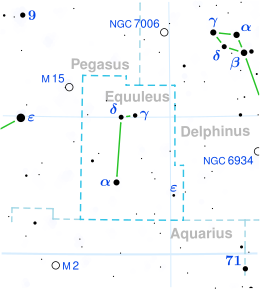| Observation data Epoch J2000 Equinox J2000 | |
|---|---|
| Constellation | Equuleus [1] |
| Right ascension | 21h 08m 28.1388s [2] |
| Declination | +06° 59′ 21.695″ [2] |
| Apparent magnitude (V) | 6.14 [1] |
| Characteristics | |
| Evolutionary stage | red giant branch? [3] |
| Spectral type | M0 III [4] |
| U−B color index | +1.97 [5] |
| B−V color index | +1.66 [5] |
| Astrometry | |
| Radial velocity (Rv) | 20 ± 2 [6] km/s |
| Proper motion (μ) | RA: −10.643 mas/yr [2] Dec.: +2.479 mas/yr [2] |
| Parallax (π) | 2.8646±0.0533 mas [2] |
| Distance | 1,140 ± 20 ly (349 ± 6 pc) |
| Absolute magnitude (MV) | −0.39 [7] |
| Details | |
| Mass | 1.83 [8] M☉ |
| Radius | 117 [8] R☉ |
| Luminosity | 1,648 [9] L☉ |
| Surface gravity (log g) | 0.413 [10] cgs |
| Temperature | 3,732 [9] K |
| Rotational velocity (v sin i) | 4.5 ± 1 [11] km/s |
| Other designations | |
| 12 G. Equueli, AG+06°2888, BD+06°4754, FK5 3692, GC 29548, HD 201298, HIP 104357, HR 8090, SAO 126566 [12] [13] | |
| Database references | |
| SIMBAD | data |
HD 201298 (HR 8090) is a solitary star located in the northern constellation Equuleus just next to 3 Equulei It has an apparent magnitude of 6.14, [1] making it barely visible to the naked eye under ideal conditions. The star is situated at a distance of 1,140 light years [2] but is drifting away with a heliocentric radial velocity of 20 km/s . [6]
HD 201298 has a stellar classification of M0 III, indicating that it is ageing M-type star [4] that is probably on the red giant branch. [3] As a result, it has expanded to 117 times the Sun's girth. [8] At present it has 1.83 times the mass of the Sun [8] and shines with a luminosity of 1,648 L☉ from its enlarged photosphere at an effective temperature of 3,732 K, [9] which gives it an orange glow. HD 201298 spins leisurely with a projected rotational velocity of 4.5±1 km/s , [11] slightly faster than most giants.
